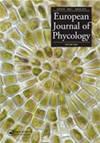Programmed cell death in the coccoid green microalga Ankistrodesmus densus Korshikov (Sphaeropleales, Selenastraceae)
IF 1.7
4区 生物学
Q2 MARINE & FRESHWATER BIOLOGY
引用次数: 5
Abstract
Abstract Reports of programmed cell death (PCD) across the taxonomic spectrum of photosynthetic unicellular organisms raise questions concerning its ecological and evolutionary roles. However, prior to ecological studies or evolutionary interpretations, it is essential to document phenotypic changes associated with PCD at the single-cell level, since death-related responses vary between taxa and within a single taxon depending on environmental stimuli. Here, we report responses to rapidly changing light, temperature and fluctuations in macronutrients in the model selenastracean green microalga Ankistrodesmus densus (Chlorophyta, Chlorophyceae, Sphaeropleales). We used stringent, but environmentally appropriate, conditions of prolonged darkness, nitrogen starvation (4 days), heat (1 h at 44°C) and cold shock (3 h at 2 ± 2°C). PCD phenotypes were examined by ultrastructural changes, phosphatidylserine (PS) externalization and DNA degradation. Flow cytometric Annexin V FITC analyses revealed that darkness and nitrogen-deprived cultures had significantly higher proportions of cells with PS externalization compared with controls (p < 0.05). Heat and cold treatments did not affect PS externalization (p = 0.44 and p = 0.99, respectively). Transmission electron microscopy (TEM) of light-deprived cells demonstrated, among other ultrastructural changes, marked cytoplasmic vacuolization suggesting a subtype of PCD known as vacuolar cell death. Nitrogen-starved cells had less vacuolization but presented more typical ultrastructural markers of PCD such as chromatin condensation and marginalization. In contrast, the more severe heat and cold shock treatments resulted in necrotic-like features. These findings suggest that prolonged darkness and nitrogen starvation induce PCD in a small (8.4 3.5 and 7.42 2.6%, respectively) but significant (p < 0.05) fraction of the A. densus population. Documenting these different death-related phenotypes depending on different environmental inducers is essential for interpreting ecological studies. Furthermore, our data support the hypothesis that autophagic/vacuolar cell death (VCD), which is central to organism homeostasis in plants (Streptophyta), occurs in Chlorophyta. VCD probably arose long before the evolution of multicellularity in plants. HIGHLIGHTS Darkness and nitrogen deprivation induce different programmed cell death markers in Ankistrodesmus densus; Plant vacuolar-like cell death occurs in Chlorophyta; There is crossover between the vacuolar and apoptosis-like death morphotypes.球藻绿色微藻Ankistrodesmus densus Korshikov细胞程序性死亡
关于光合单细胞生物的程序性细胞死亡(PCD)的报道提出了关于其生态和进化作用的问题。然而,在生态学研究或进化解释之前,有必要在单细胞水平上记录与PCD相关的表型变化,因为死亡相关的反应在分类群之间和单个分类群内取决于环境刺激而变化。在这里,我们报道了模型硒纲绿色微藻Ankistrodesmus densus(绿藻,绿藻科,球形藻)对快速变化的光、温度和常量营养素波动的响应。我们使用严格但环境适宜的条件,包括长时间黑暗、氮饥饿(4天)、加热(44°C下1小时)和冷休克(2±2°C下3小时)。通过超微结构变化、磷脂酰丝氨酸(PS)外化和DNA降解检测PCD表型。流式细胞仪Annexin V FITC分析显示,暗培养和无氮培养中PS外化细胞比例显著高于对照组(p < 0.05)。冷热处理对PS外化无显著影响(p = 0.44, p = 0.99)。光剥夺细胞的透射电镜(TEM)显示,在其他超微结构变化中,细胞质空泡化明显,提示PCD的一种亚型,即空泡细胞死亡。氮饥饿细胞空泡化程度较低,但呈现出染色质凝聚和边缘化等典型的PCD超微结构标记。相比之下,更严重的热和冷休克治疗导致坏死样特征。上述结果表明,长时间黑暗和氮饥饿对密度白蚁种群PCD的诱导作用虽小,但显著(p < 0.05)(分别为8.3.4 %和7.42 2.6%)。根据不同的环境诱导剂记录这些不同的死亡相关表型对于解释生态学研究至关重要。此外,我们的数据支持了自噬/液泡细胞死亡(VCD)的假设,这是植物(链藻类)生物稳态的核心,发生在绿藻中。VCD可能早在植物多细胞进化之前就出现了。黑暗和氮剥夺诱导密度按蚊不同的程序性细胞死亡标记;植物液泡样细胞死亡发生在绿藻中;在空泡型和细胞凋亡样死亡形态之间存在交叉。
本文章由计算机程序翻译,如有差异,请以英文原文为准。
求助全文
约1分钟内获得全文
求助全文
来源期刊

European Journal of Phycology
生物-海洋与淡水生物学
CiteScore
4.80
自引率
4.20%
发文量
37
审稿时长
>12 weeks
期刊介绍:
The European Journal of Phycology is an important focus for the activities of algal researchers all over the world. The Editors-in-Chief are assisted by an international team of Associate Editors who are experts in the following fields: macroalgal ecology, microalgal ecology, physiology and biochemistry, cell biology, molecular biology, macroalgal and microalgal systematics, applied phycology and biotechnology. The European Journal of Phycology publishes papers on all aspects of algae, including cyanobacteria. Articles may be in the form of primary research papers and reviews of topical subjects.
The journal publishes high quality research and is well cited, with a consistently good Impact Factor.
 求助内容:
求助内容: 应助结果提醒方式:
应助结果提醒方式:


